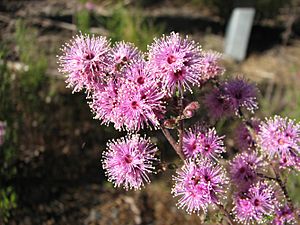Violet kunzea facts for kids
Quick facts for kids Violet kunzea |
|
|---|---|
 |
|
| Kunzea parvifolia Mount Buffalo National Park, Victoria |
|
| Scientific classification | |
| Genus: |
Kunzea
|
| Species: |
parvifolia
|
The Violet Kunzea (scientific name: Kunzea parvifolia) is a beautiful flowering plant. It belongs to the myrtle family, called Myrtaceae. This plant is special because it only grows naturally in eastern Australia. It's a bushy plant with thin, flexible branches. You'll see its small, narrow leaves and lovely pink to purple flowers in spring.
What Does the Violet Kunzea Look Like?
The Violet Kunzea is a thin, bushy plant. It usually grows to be about 0.5 to 1.5 meters (1.6 to 4.9 feet) tall. Its young branches are covered with soft, fine hairs.
The leaves are long and narrow, almost like tiny spears. They are usually pressed close to the stem. Each leaf is about 1 to 4 millimeters (0.04 to 0.16 inches) long. They are about 1 millimeter (0.04 inches) wide. When they are young, the leaves also have soft hairs.
The flowers grow in groups, usually with three to eight flowers in each cluster. These clusters appear at the ends of the branches. Each flower has a small cup-like base called a floral cup. This cup is about 1.5 to 2.5 millimeters (0.06 to 0.10 inches) long.
At the base of the flowers, there are small, egg-shaped leaves called bracts. These bracts are about 2.5 to 3.5 millimeters (0.10 to 0.14 inches) long. There are also tiny paired bracteoles right where the flowers begin.
The sepals, which are like small leaves protecting the flower bud, are triangular. They are about 1.5 millimeters (0.06 inches) long and have a pointed tip. The petals are usually pink to purple, but sometimes they can be white. They are egg-shaped or almost round, about 2 millimeters (0.08 inches) long.
Each flower has many stamens, which are the parts that produce pollen. There are usually 30 to 40 stamens, each about 2 to 3.5 millimeters (0.08 to 0.14 inches) long. The style, which is the part that receives pollen, is about 2.5 to 3.5 millimeters (0.10 to 0.14 inches) long.
Violet Kunzea plants mostly flower in October and November. After flowering, they produce urn-shaped fruits. These fruits are called capsules and are about 2 millimeters (0.08 inches) long and wide.
How Did It Get Its Name?
The Violet Kunzea was first officially described in 1844. A scientist named Johannes Conrad Schauer wrote about it. His description was published in a book called Plantae Preissianae.
The second part of its scientific name, parvifolia, comes from two Latin words. Parvus means "small" and folium means "leaf". So, parvifolia means "small-leaved", which describes the plant's tiny leaves.
Where Does the Violet Kunzea Grow?
This type of kunzea plant grows in forests and heathlands. You can find it in eastern New South Wales, starting from a place called Torrington and going south. It also grows in Victoria, mostly in the north-east. There are also a few places further west in Victoria where it can be found.

